remote control MERCEDES-BENZ SPRINTER 2014 MY14 Operator’s Manual
[x] Cancel search | Manufacturer: MERCEDES-BENZ, Model Year: 2014, Model line: SPRINTER, Model: MERCEDES-BENZ SPRINTER 2014Pages: 338, PDF Size: 6.78 MB
Page 7 of 338
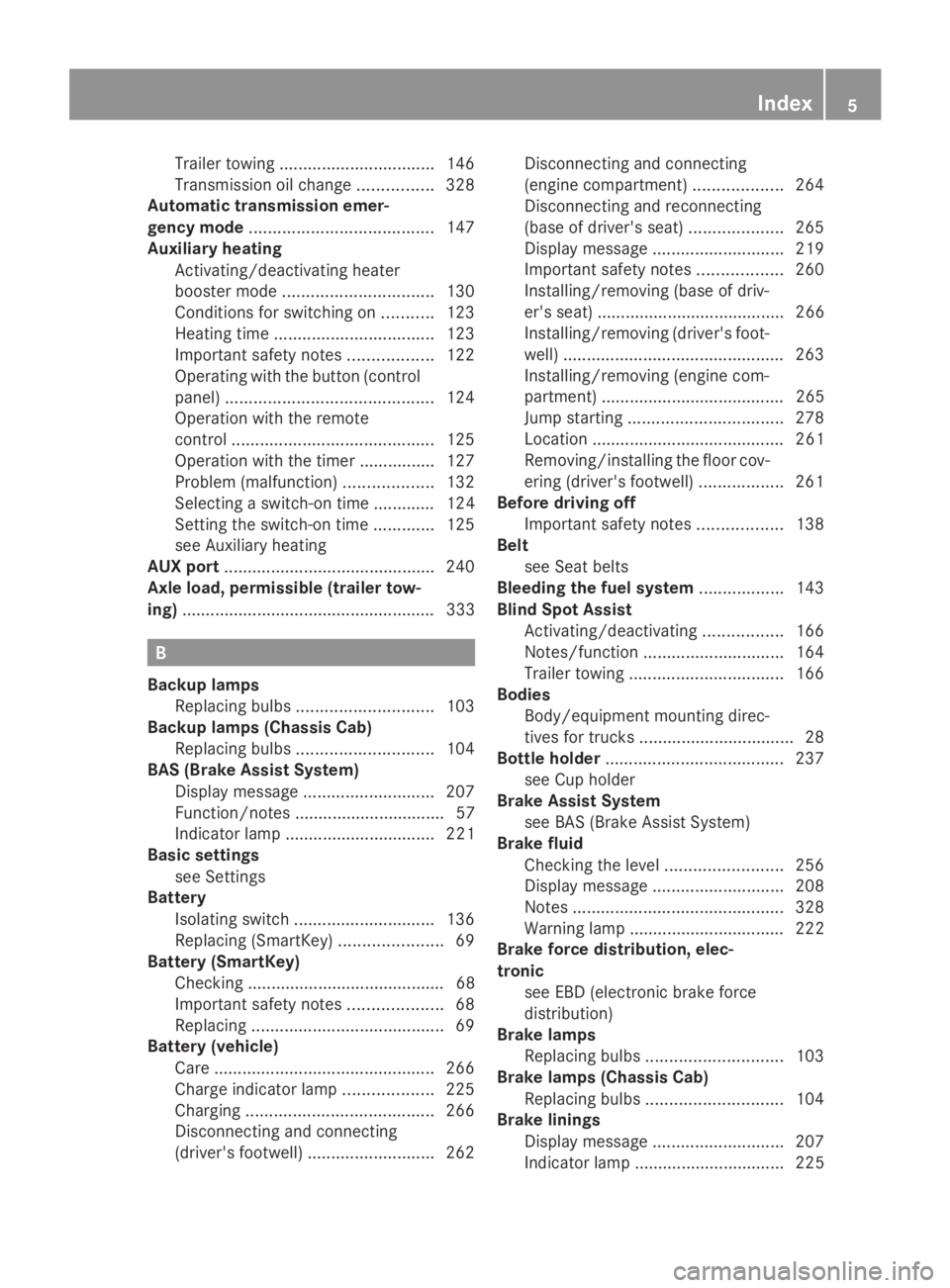
Trailer towing
................................. 146
Transmission oil change ................328
Automatic transmission emer-
gency mode ....................................... 147
Auxiliary heating Activating/deactivating heater
booster mode ................................ 130
Conditions for switching on ...........123
Heating time .................................. 123
Important safety notes ..................122
Operating with the button (control
panel) ............................................ 124
Operation with the remote
control ........................................... 125
Operation with the timer ................127
Problem (malfunction) ...................132
Selecting a switch-on time ............. 124
Setting the switch-on time .............125
see Auxiliary heating
AUX port ............................................ .240
Axle load, permissible (trailer tow-
ing) ...................................................... 333 B
Backup lamps Replacing bulbs ............................. 103
Backup lamps (Chassis Cab)
Replacing bulbs ............................. 104
BAS (Brake Assist System)
Display message ............................ 207
Function/notes ................................ 57
Indicator lamp ................................ 221
Basic settings
see Settings
Battery
Isolating switch .............................. 136
Replacing (SmartKey) ......................69
Battery (SmartKey)
Checking .......................................... 68
Important safety notes ....................68
Replacing ......................................... 69
Battery (vehicle)
Care ............................................... 266
Charge indicator lamp ...................225
Charging ........................................ 266
Disconnecting and connecting
(driver's footwell) ........................... 262Disconnecting and connecting
(engine compartment)
...................264
Disconnecting and reconnecting
(base of driver's seat) ....................265
Display message ............................ 219
Important safety notes ..................260
Installing/removing (base of driv-
er's seat) ........................................ 266
Installing/removing (driver's foot-
well) ............................................... 263
Installing/removing (engine com-
partment) ....................................... 265
Jump starting ................................. 278
Location ......................................... 261
Removing/installing the floor cov-
ering (driver's footwell) ..................261
Before driving off
Important safety notes ..................138
Belt
see Seat belts
Bleeding the fuel system ..................143
Blind Spot Assist Activating/deactivating .................166
Notes/function .............................. 164
Trailer towing ................................. 166
Bodies
Body/equipment mounting direc-
tives for trucks ................................. 28
Bottle holder ...................................... 237
see Cup holder
Brake Assist System
see BAS (Brake Assist System)
Brake fluid
Checking the level .........................256
Display message ............................ 208
Notes ............................................. 328
Warning lamp ................................. 222
Brake force distribution, elec-
tronic
see EBD (electronic brake force
distribution)
Brake lamps
Replacing bulbs ............................. 103
Brake lamps (Chassis Cab)
Replacing bulbs ............................. 104
Brake linings
Display message ............................ 207
Indicator lamp ................................ 225 Index
5
Page 18 of 338
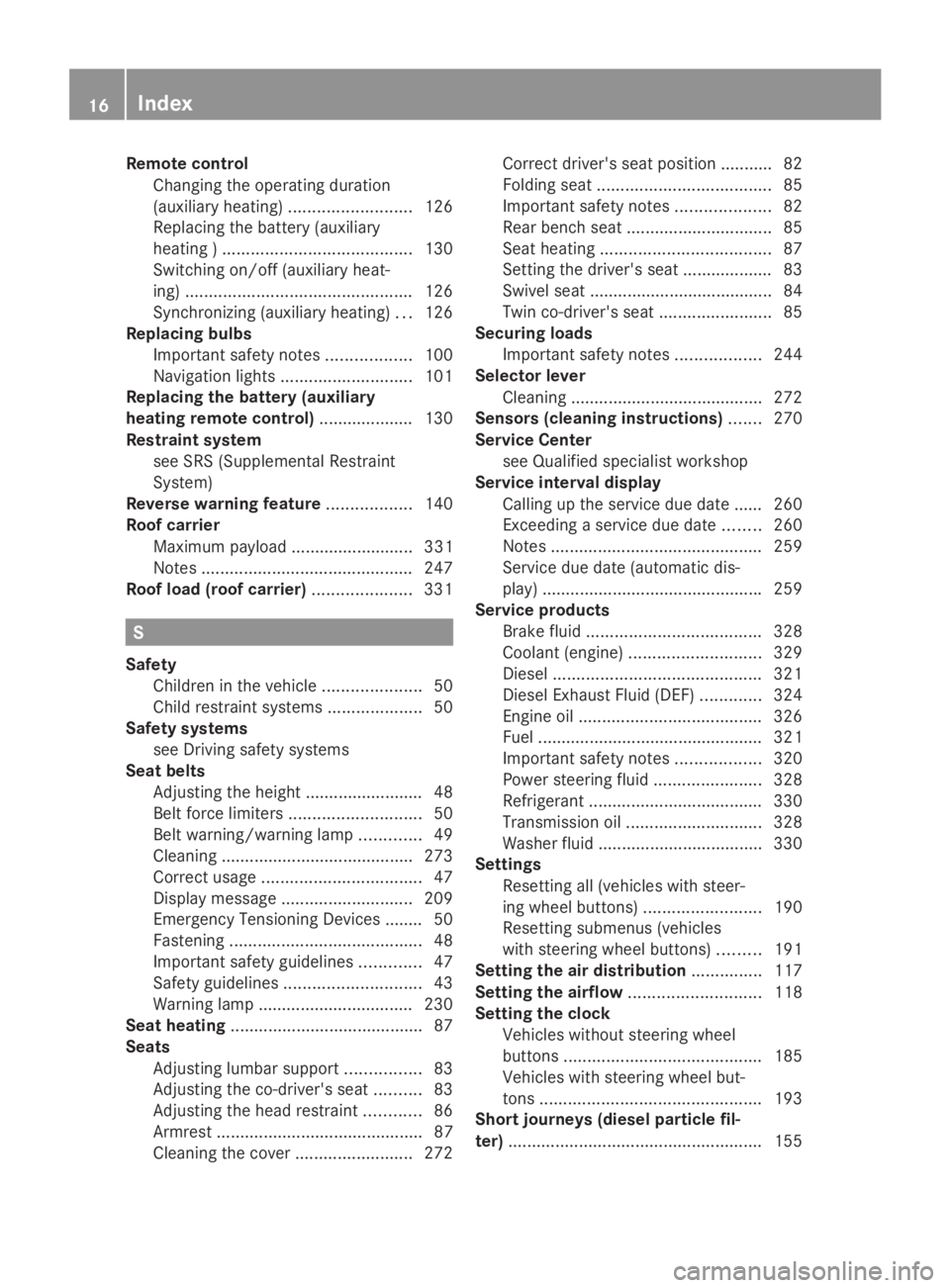
Remote control
Changing the operating duration
(auxiliary heating) .......................... 126
Replacing the battery (auxiliary
heating ) ........................................ 130
Switching on/off (auxiliary heat-
ing) ................................................ 126
Synchronizing (auxiliary heating) ...126
Replacing bulbs
Important safety notes ..................100
Navigation lights ............................ 101
Replacing the battery (auxiliary
heating remote control) .................... 130
Restraint system see SRS (Supplemental Restraint
System)
Reverse warning feature ..................140
Roof carrier Maximum payloa d.......................... 331
Notes ............................................. 247
Roof load (roof carrier) .....................331 S
Safety Children in the vehicle .....................50
Child restraint systems ....................50
Safety systems
see Driving safety systems
Seat belts
Adjusting the height ......................... 48
Belt force limiters ............................ 50
Belt warning/warning lamp .............49
Cleaning ......................................... 273
Correct usage .................................. 47
Display message ............................ 209
Emergency Tensioning Devices ....... .50
Fastening ......................................... 48
Important safety guidelines .............47
Safety guidelines ............................. 43
Warning lamp ................................. 230
Seat heating ........................................ .87
Seats Adjusting lumbar support ................83
Adjusting the co-driver's sea t.......... 83
Adjusting the head restraint ............86
Armrest ............................................ 87
Cleaning the cover .........................272Correct driver's seat position ........... 82
Folding seat
..................................... 85
Important safety notes ....................82
Rear bench seat ............................... 85
Seat heating .................................... 87
Setting the driver's seat ................... 83
Swivel seat ....................................... 84
Twin co-driver's seat ........................85
Securing loads
Important safety notes ..................244
Selector lever
Cleaning ......................................... 272
Sensors (cleaning instructions) .......270
Service Center see Qualified specialist workshop
Service interval display
Calling up the service due date ...... 260
Exceeding a service due date ........260
Notes ............................................. 259
Service due date (automatic dis-
play) .............................................. .259
Service products
Brake fluid ..................................... 328
Coolant (engine) ............................ 329
Diesel ............................................ 321
Diesel Exhaust Fluid (DEF) .............324
Engine oil ....................................... 326
Fuel ................................................ 321
Important safety notes ..................320
Power steering fluid .......................328
Refrigerant ..................................... 330
Transmission oil ............................. 328
Washer fluid .................................. .330
Settings
Resetting all (vehicles with steer-
ing wheel buttons) .........................190
Resetting submenus (vehicles
with steering wheel buttons) .........191
Setting the air distribution ...............117
Setting the airflow ............................118
Setting the clock Vehicles without steering wheel
buttons .......................................... 185
Vehicles with steering wheel but-
tons ............................................... 193
Short journeys (diesel particle fil-
ter) ...................................................... 15516
Index
Page 26 of 338
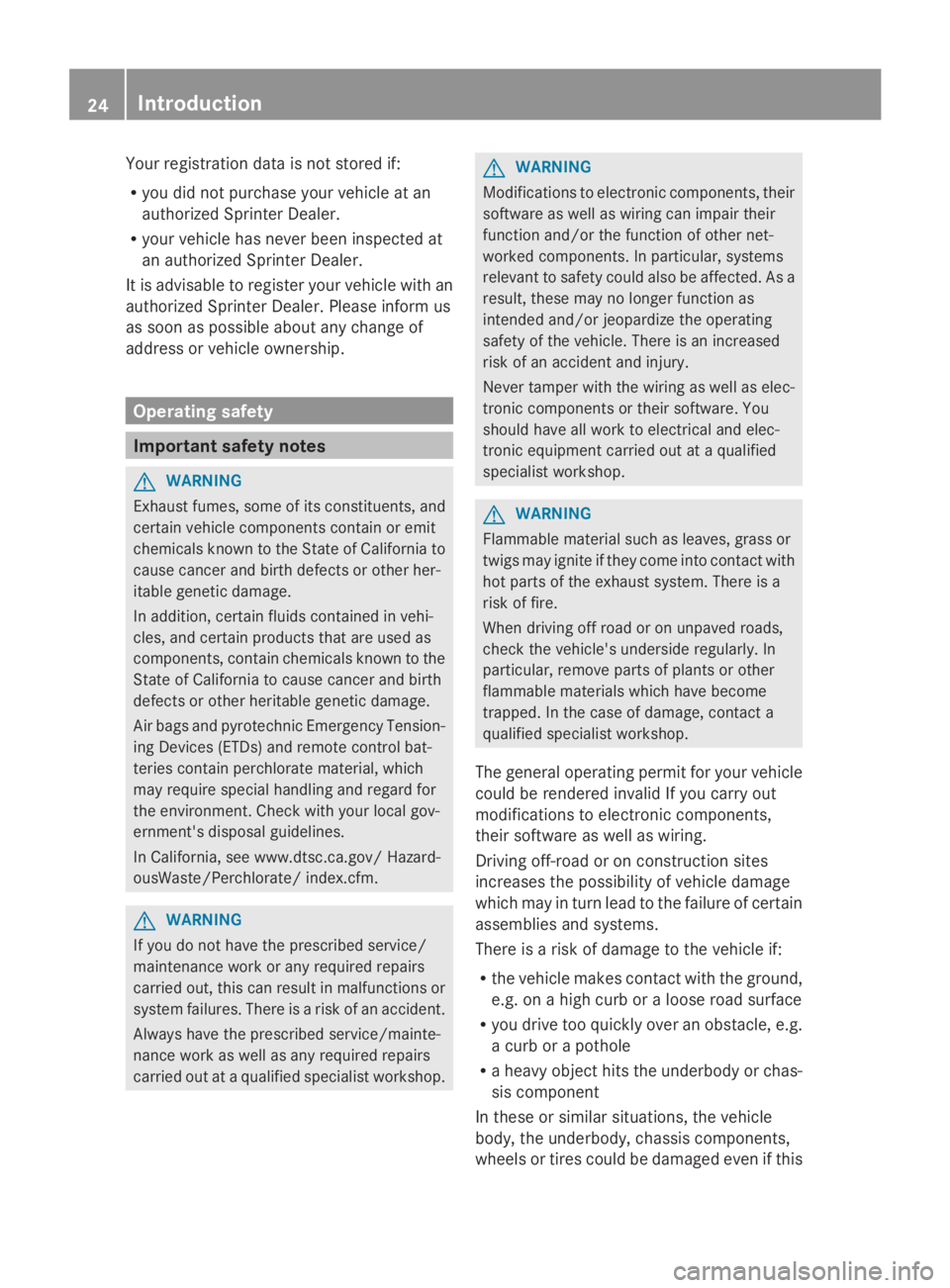
Your registration data is not stored if:
R you did not purchase your vehicle at an
authorized Sprinter Dealer.
R your vehicle has never been inspected at
an authorized Sprinter Dealer.
It is advisable to register your vehicle with an
authorized Sprinter Dealer. Please inform us
as soon as possible about any change of
address or vehicle ownership. Operating safety
Important safety notes
G
WARNING
Exhaust fumes, some of its constituents, and
certain vehicle components contain or emit
chemicals known to the State of California to
cause cancer and birth defects or other her-
itable genetic damage.
In addition, certain fluids contained in vehi-
cles, and certain products that are used as
components, contain chemicals known to the
State of California to cause cancer and birth
defects or other heritable genetic damage.
Air bags and pyrotechnic Emergency Tension-
ing Devices (ETDs) and remote control bat-
teries contain perchlorate material, which
may require special handling and regard for
the environment. Check with your local gov-
ernment's disposal guidelines.
In California, see www.dtsc.ca.gov/ Hazard-
ousWaste/Perchlorate/ index.cfm. G
WARNING
If you do not have the prescribed service/
maintenance work or any required repairs
carried out, this can result in malfunctions or
system failures. There is a risk of an accident.
Always have the prescribed service/mainte-
nance work as well as any required repairs
carried out at a qualified specialist workshop. G
WARNING
Modifications to electronic components, their
software as well as wiring can impair their
function and/or the function of other net-
worked components. In particular, systems
relevant to safety could also be affected. As a
result, these may no longer function as
intended and/or jeopardize the operating
safety of the vehicle. There is an increased
risk of an accident and injury.
Never tamper with the wiring as well as elec-
tronic components or their software. You
should have all work to electrical and elec-
tronic equipment carried out at a qualified
specialist workshop. G
WARNING
Flammable material such as leaves, grass or
twigs may ignite if they come into contact with
hot parts of the exhaust system. There is a
risk of fire.
When driving off road or on unpaved roads,
check the vehicle's underside regularly. In
particular, remove parts of plants or other
flammable materials which have become
trapped. In the case of damage, contact a
qualified specialist workshop.
The general operating permit for your vehicle
could be rendered invalid If you carry out
modifications to electronic components,
their software as well as wiring.
Driving off-road or on construction sites
increases the possibility of vehicle damage
which may in turn lead to the failure of certain
assemblies and systems.
There is a risk of damage to the vehicle if:
R the vehicle makes contact with the ground,
e.g. on a high curb or a loose road surface
R you drive too quickly over an obstacle, e.g.
a curb or a pothole
R a heavy object hits the underbody or chas-
sis component
In these or similar situations, the vehicle
body, the underbody, chassis components,
wheels or tires could be damaged even if this 24
Introduction
Page 65 of 338
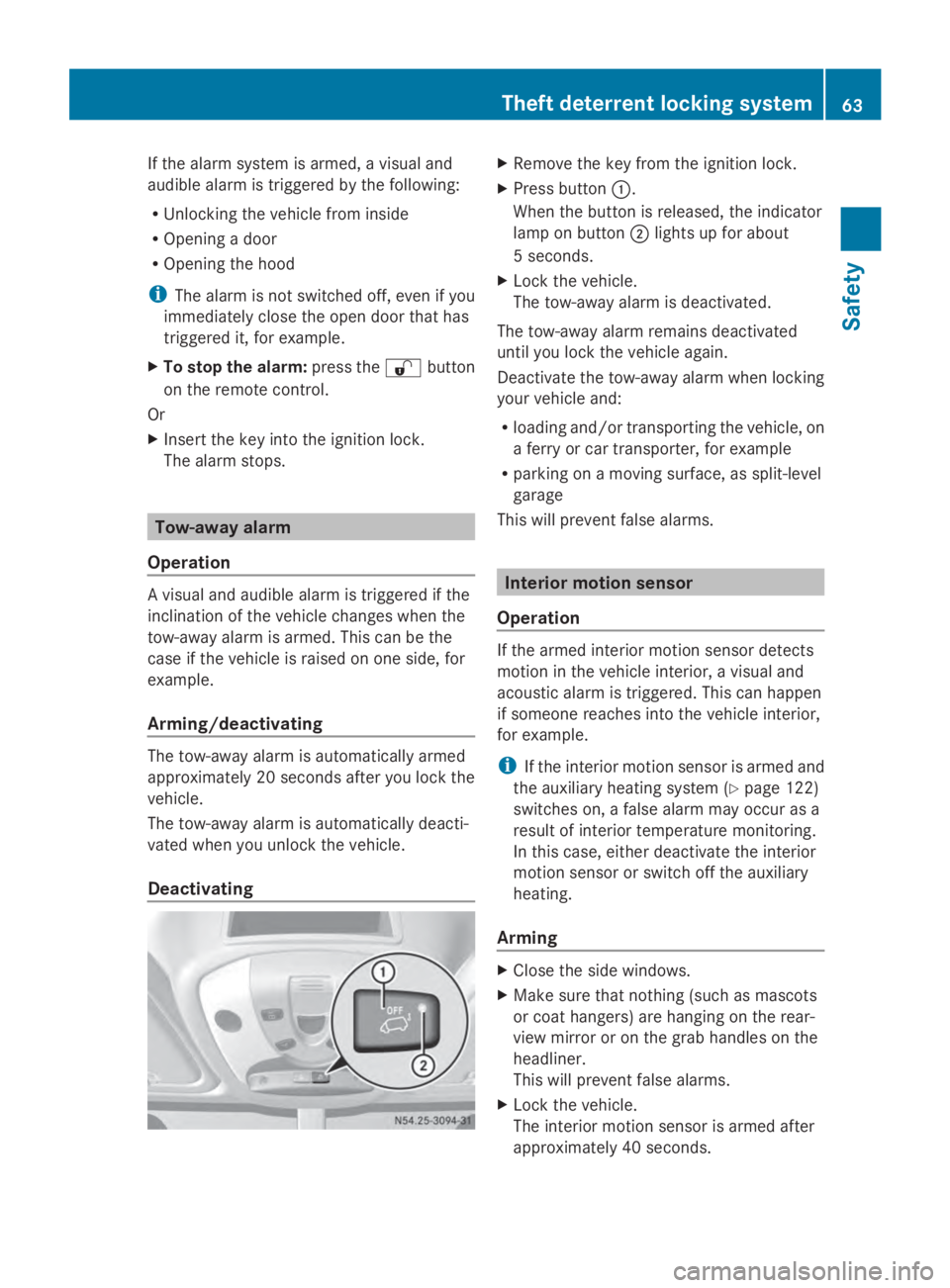
If the alarm system is armed, a visual and
audible alarm is triggered by the following:
R Unlocking the vehicle from inside
R Opening a door
R Opening the hood
i The alarm is not switched off, even if you
immediately close the open door that has
triggered it, for example.
X To stop the alarm: press the0036button
on the remote control.
Or
X Insert the key into the ignition lock.
The alarm stops. Tow-away alarm
Operation A visual and audible alarm is triggered if the
inclination of the vehicle changes when the
tow-away alarm is armed. This can be the
case if the vehicle is raised on one side, for
example.
Arming/deactivating The tow-away alarm is automatically armed
approximately 20 seconds after you lock the
vehicle.
The tow-away alarm is automatically deacti-
vated when you unlock the vehicle.
Deactivating X
Remove the key from the ignition lock.
X Press button 0043.
When the button is released, the indicator
lamp on button 0044lights up for about
5 seconds.
X Lock the vehicle.
The tow-away alarm is deactivated.
The tow-away alarm remains deactivated
until you lock the vehicle again.
Deactivate the tow-away alarm when locking
your vehicle and:
R loading and/or transporting the vehicle, on
a ferry or car transporter, for example
R parking on a moving surface, as split-level
garage
This will prevent false alarms. Interior motion sensor
Operation If the armed interior motion sensor detects
motion in the vehicle interior, a visual and
acoustic alarm is triggered. This can happen
if someone reaches into the vehicle interior,
for example.
i
If the interior motion sensor is armed and
the auxiliary heating system (Y page 122)
switches on, a false alarm may occur as a
result of interior temperature monitoring.
In this case, either deactivate the interior
motion sensor or switch off the auxiliary
heating.
Arming X
Close the side windows.
X Make sure that nothing (such as mascots
or coat hangers) are hanging on the rear-
view mirror or on the grab handles on the
headliner.
This will prevent false alarms.
X Lock the vehicle.
The interior motion sensor is armed after
approximately 40 seconds. Theft deterrent locking system
63Safety Z
Page 68 of 338
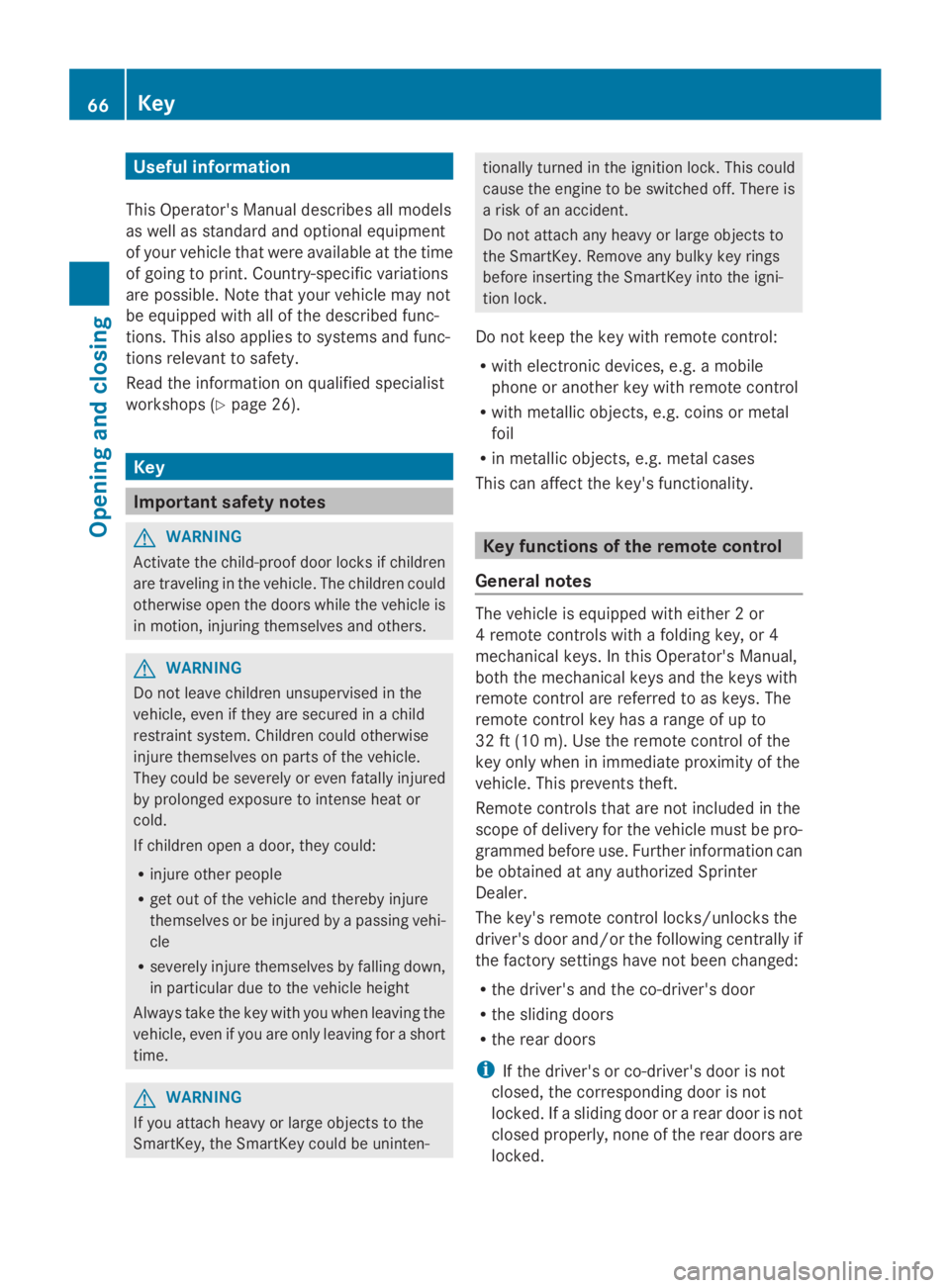
Useful information
This Operator's Manual describes all models
as well as standard and optional equipment
of your vehicle that were available at the time
of going to print. Country-specific variations
are possible. Note that your vehicle may not
be equipped with all of the described func-
tions. This also applies to systems and func-
tions relevant to safety.
Read the information on qualified specialist
workshops (Y page 26). Key
Important safety notes
G
WARNING
Activate the child-proof door locks if children
are traveling in the vehicle. The children could
otherwise open the doors while the vehicle is
in motion, injuring themselves and others. G
WARNING
Do not leave children unsupervised in the
vehicle, even if they are secured in a child
restraint system. Children could otherwise
injure themselves on parts of the vehicle.
They could be severely or even fatally injured
by prolonged exposure to intense heat or
cold.
If children open a door, they could:
R injure other people
R get out of the vehicle and thereby injure
themselves or be injured by a passing vehi-
cle
R severely injure themselves by falling down,
in particular due to the vehicle height
Always take the key with you when leaving the
vehicle, even if you are only leaving for a short
time. G
WARNING
If you attach heavy or large objects to the
SmartKey, the SmartKey could be uninten- tionally turned in the ignition lock. This could
cause the engine to be switched off. There is
a risk of an accident.
Do not attach any heavy or large objects to
the SmartKey. Remove any bulky key rings
before inserting the SmartKey into the igni-
tion lock.
Do not keep the key with remote control:
R with electronic devices, e.g. a mobile
phone or another key with remote control
R with metallic objects, e.g. coins or metal
foil
R in metallic objects, e.g. metal cases
This can affect the key's functionality. Key functions of the remote control
General notes The vehicle is equipped with either 2 or
4 remote controls with a folding key, or 4
mechanical keys. In this Operator's Manual,
both the mechanical keys and the keys with
remote control are referred to as keys. The
remote control key has a range of up to
32 ft (10 m). Use the remote control of the
key only when in immediate proximity of the
vehicle. This prevents theft.
Remote controls that are not included in the
scope of delivery for the vehicle must be pro-
grammed before use. Further information can
be obtained at any authorized Sprinter
Dealer.
The key's remote control locks/unlocks the
driver's door and/or the following centrally if
the factory settings have not been changed:
R the driver's and the co-driver's door
R the sliding doors
R the rear doors
i If the driver's or co-driver's door is not
closed, the corresponding door is not
locked. If a sliding door or a rear door is not
closed properly, none of the rear doors are
locked. 66
KeyOpening and closing
Page 69 of 338
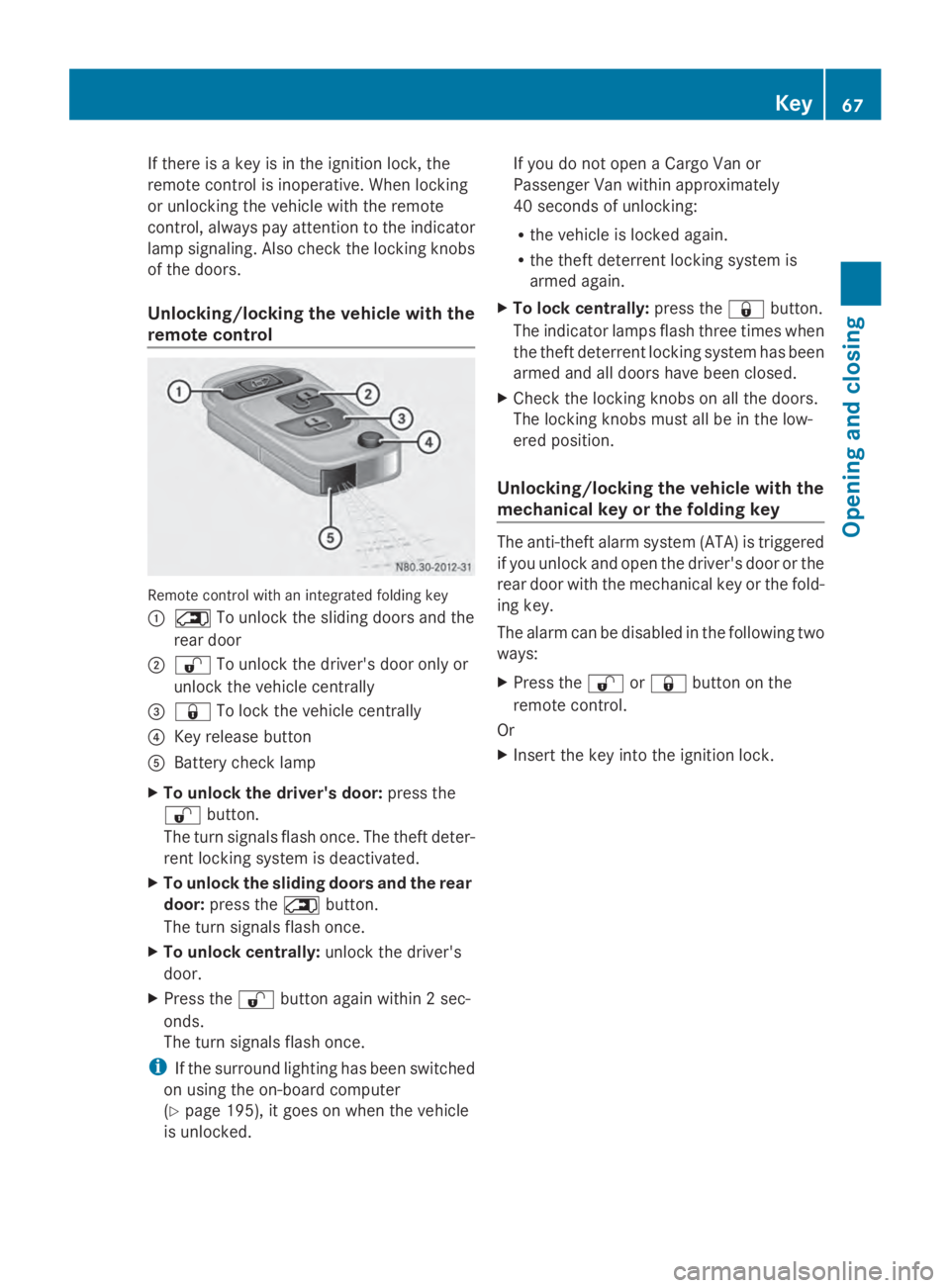
If there is a key is in the ignition lock, the
remote control is inoperative. When locking
or unlocking the vehicle with the remote
control, always pay attention to the indicator
lamp signaling. Also check the locking knobs
of the doors.
Unlocking/locking the vehicle with the
remote control Remote control with an integrated folding key
0043 0042 To unlock the sliding doors and the
rear door
0044 0036 To unlock the driver's door only or
unlock the vehicle centrally
0087 0037 To lock the vehicle centrally
0085 Key release button
0083 Battery check lamp
X To unlock the driver's door: press the
0036 button.
The turn signals flash once. The theft deter-
rent locking system is deactivated.
X To unlock the sliding doors and the rear
door: press the 0042button.
The turn signals flash once.
X To unlock centrally: unlock the driver's
door.
X Press the 0036button again within 2 sec-
onds.
The turn signals flash once.
i If the surround lighting has been switched
on using the on-board computer
(Y page 195), it goes on when the vehicle
is unlocked. If you do not open a Cargo Van or
Passenger Van within approximately
40 seconds of unlocking:
R
the vehicle is locked again.
R the theft deterrent locking system is
armed again.
X To lock centrally: press the0037button.
The indicator lamps flash three times when
the theft deterrent locking system has been
armed and all doors have been closed.
X Check the locking knobs on all the doors.
The locking knobs must all be in the low-
ered position.
Unlocking/locking the vehicle with the
mechanical key or the folding key The anti-theft alarm system (ATA) is triggered
if you unlock and open the driver's door or the
rear door with the mechanical key or the fold-
ing key.
The alarm can be disabled in the following two
ways:
X
Press the 0036or0037 button on the
remote control.
Or
X Insert the key into the ignition lock. Key
67Opening and closing Z
Page 70 of 338
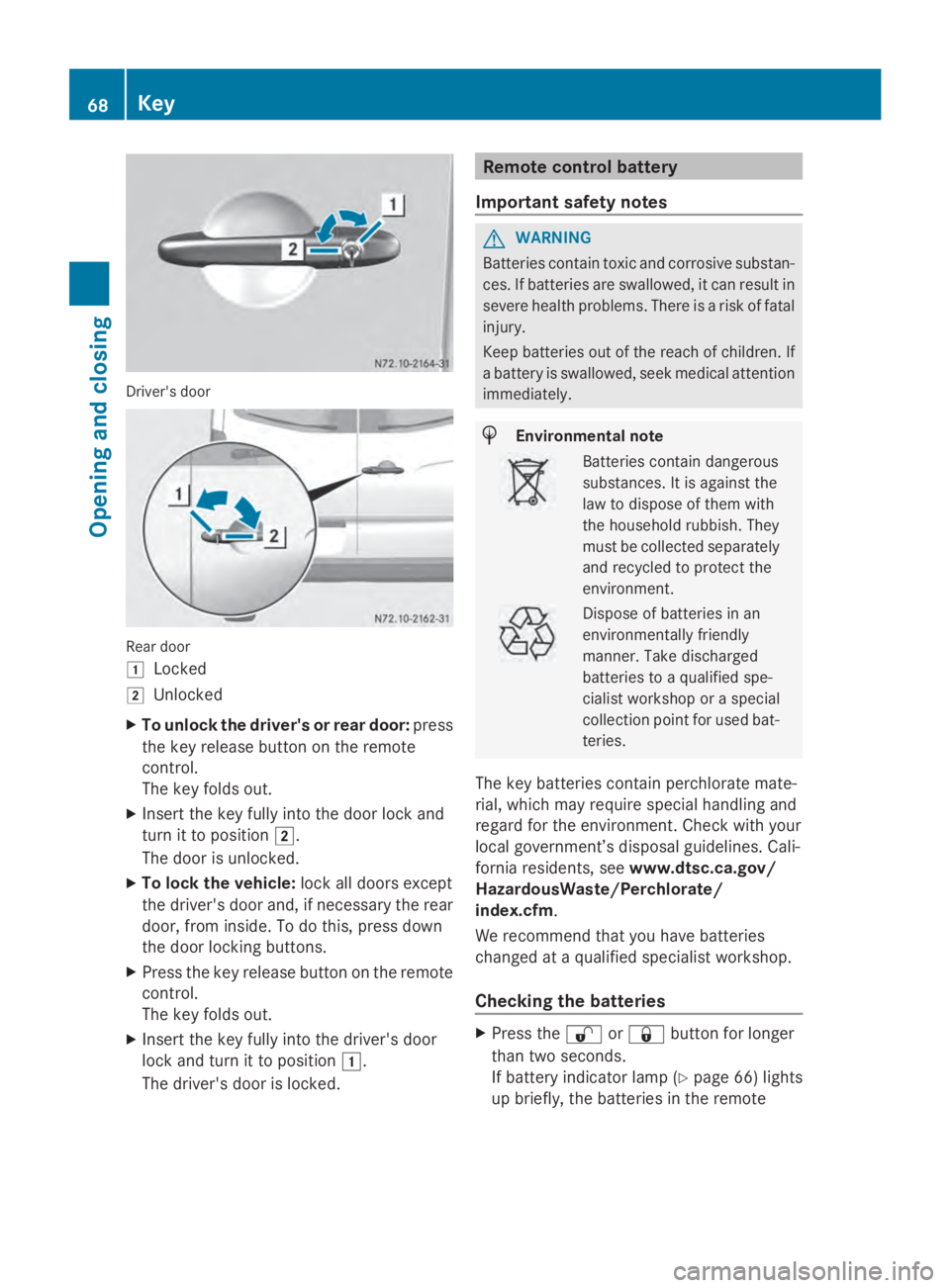
Driver's door
Rear door
0047
Locked
0048 Unlocked
X To unlock the driver's or rear door: press
the key release button on the remote
control.
The key folds out.
X Insert the key fully into the door lock and
turn it to position 0048.
The door is unlocked.
X To lock the vehicle: lock all doors except
the driver's door and, if necessary the rear
door, from inside. To do this, press down
the door locking buttons.
X Press the key release button on the remote
control.
The key folds out.
X Insert the key fully into the driver's door
lock and turn it to position 0047.
The driver's door is locked. Remote control battery
Important safety notes G
WARNING
Batteries contain toxic and corrosive substan-
ces. If batteries are swallowed, it can result in
severe health problems. There is a risk of fatal
injury.
Keep batteries out of the reach of children. If
a battery is swallowed, seek medical attention
immediately. H
Environmental note Batteries contain dangerous
substances. It is against the
law to dispose of them with
the household rubbish. They
must be collected separately
and recycled to protect the
environment.
Dispose of batteries in an
environmentally friendly
manner. Take discharged
batteries to a qualified spe-
cialist workshop or a special
collection point for used bat-
teries.
The key batteries contain perchlorate mate-
rial, which may require special handling and
regard for the environment. Check with your
local government’s disposal guidelines. Cali-
fornia residents, see www.dtsc.ca.gov/
HazardousWaste/Perchlorate/
index.cfm.
We recommend that you have batteries
changed at a qualified specialist workshop.
Checking the batteries X
Press the 0036or0037 button for longer
than two seconds.
If battery indicator lamp (Y page 66) lights
up briefly, the batteries in the remote 68
KeyOpening and closing
Page 71 of 338
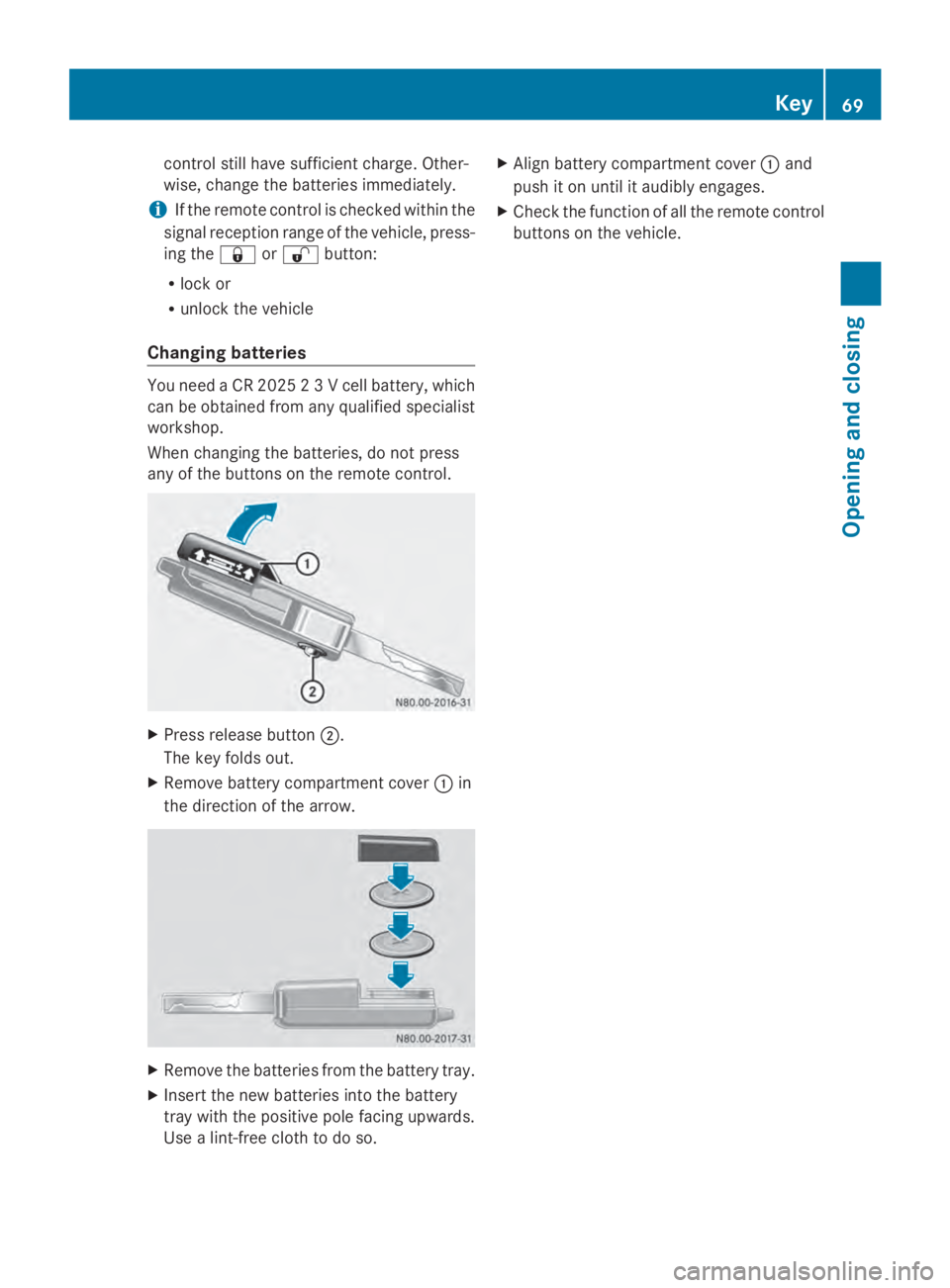
control still have sufficient charge. Other-
wise, change the batteries immediately.
i If the remote control is checked within the
signal reception range of the vehicle, press-
ing the 0037or0036 button:
R lock or
R unlock the vehicle
Changing batteries You need a CR 2025 2 3 V cell battery, which
can be obtained from any qualified specialist
workshop.
When changing the batteries, do not press
any of the buttons on the remote control. X
Press release button 0044.
The key folds out.
X Remove battery compartment cover 0043in
the direction of the arrow. X
Remove the batteries from the battery tray.
X Insert the new batteries into the battery
tray with the positive pole facing upwards.
Use a lint-free cloth to do so. X
Align battery compartment cover 0043and
push it on until it audibly engages.
X Check the function of all the remote control
buttons on the vehicle. Key
69Opening and closing Z
Page 72 of 338
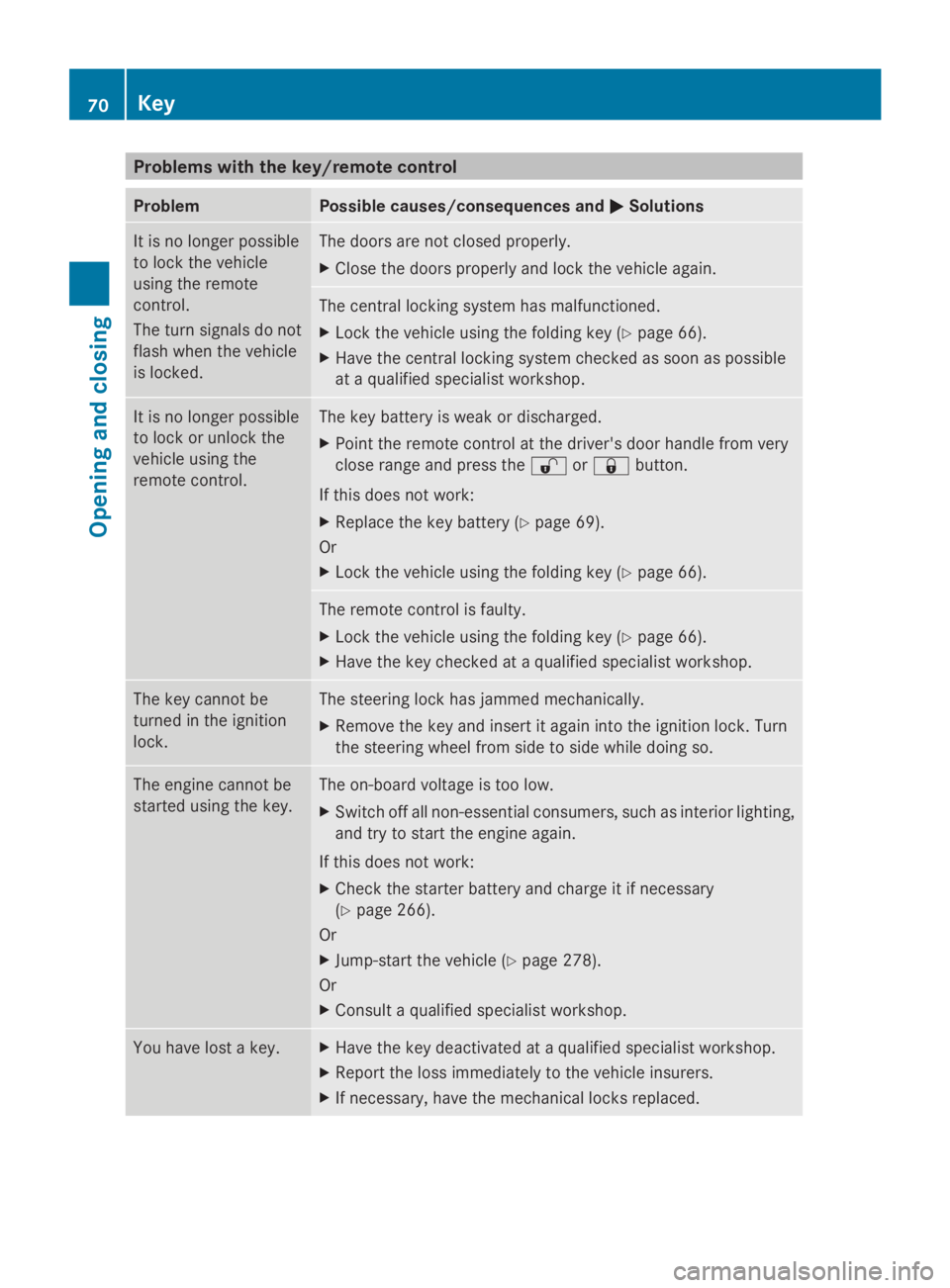
Problems with the key/remote control
Problem Possible causes/consequences and
0050
0050Solutions It is no longer possible
to lock the vehicle
using the remote
control.
The turn signals do not
flash when the vehicle
is locked. The doors are not closed properly.
X
Close the doors properly and lock the vehicle again. The central locking system has malfunctioned.
X
Lock the vehicle using the folding key (Y page 66).
X Have the central locking system checked as soon as possible
at a qualified specialist workshop. It is no longer possible
to lock or unlock the
vehicle using the
remote control. The key battery is weak or discharged.
X
Point the remote control at the driver's door handle from very
close range and press the 0036or0037 button.
If this does not work:
X Replace the key battery (Y page 69).
Or
X Lock the vehicle using the folding key (Y page 66). The remote control is faulty.
X
Lock the vehicle using the folding key (Y page 66).
X Have the key checked at a qualified specialist workshop. The key cannot be
turned in the ignition
lock. The steering lock has jammed mechanically.
X
Remove the key and insert it again into the ignition lock. Turn
the steering wheel from side to side while doing so. The engine cannot be
started using the key. The on-board voltage is too low.
X Switch off all non-essential consumers, such as interior lighting,
and try to start the engine again.
If this does not work:
X Check the starter battery and charge it if necessary
(Y page 266).
Or
X Jump-start the vehicle (Y page 278).
Or
X Consult a qualified specialist workshop. You have lost a key. X
Have the key deactivated at a qualified specialist workshop.
X Report the loss immediately to the vehicle insurers.
X If necessary, have the mechanical locks replaced. 70
KeyOpening and closing
Page 124 of 338
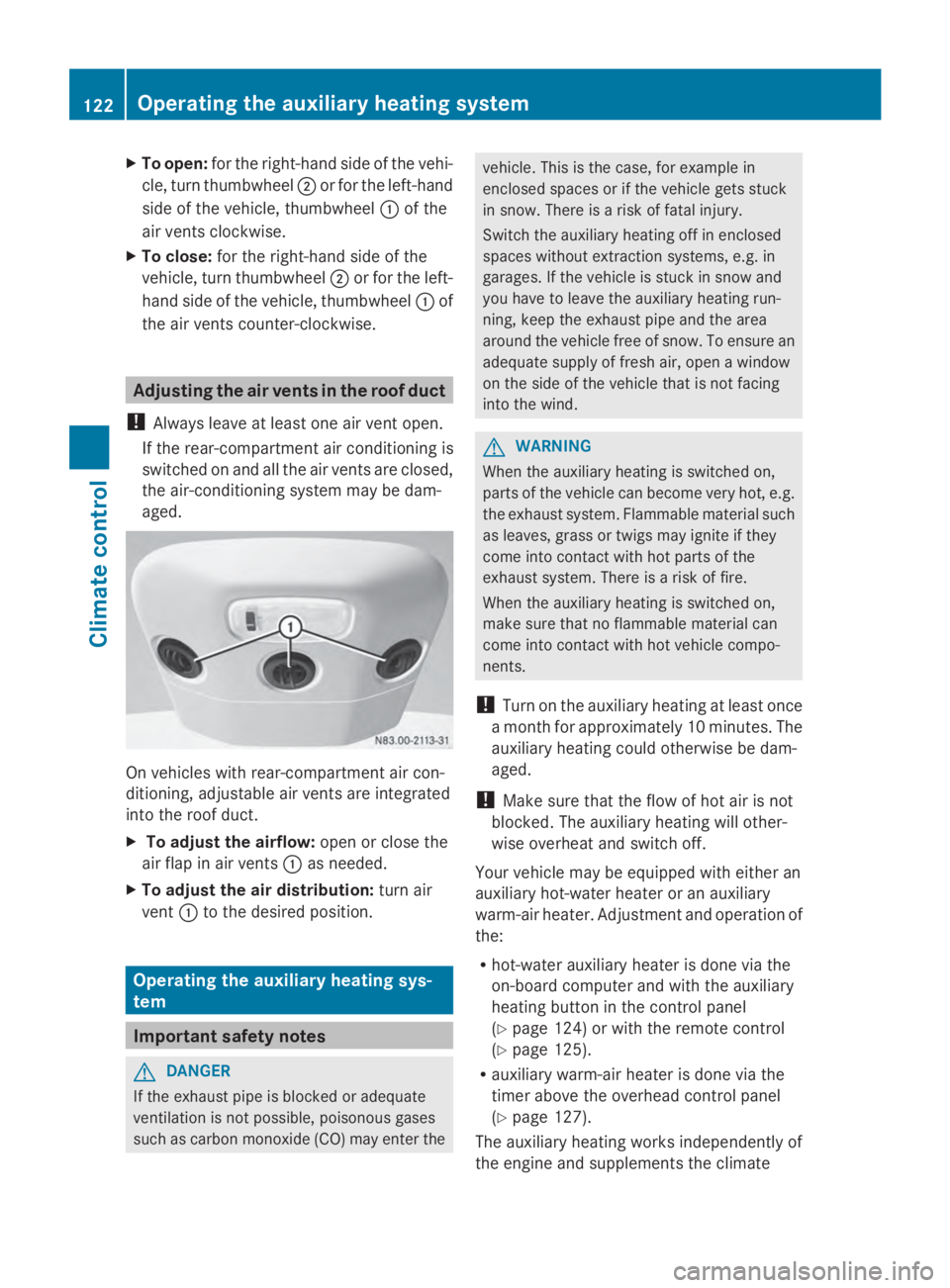
X
To open: for the right-hand side of the vehi-
cle, turn thumbwheel 0044or for the left-hand
side of the vehicle, thumbwheel 0043of the
air vents clockwise.
X To close: for the right-hand side of the
vehicle, turn thumbwheel 0044or for the left-
hand side of the vehicle, thumbwheel 0043of
the air vents counter-clockwise. Adjusting the air vents in the roof duct
! Always leave at least one air vent open.
If the rear-compartment air conditioning is
switched on and all the air vents are closed,
the air-conditioning system may be dam-
aged. On vehicles with rear-compartment air con-
ditioning, adjustable air vents are integrated
into the roof duct.
X To adjust the airflow: open or close the
air flap in air vents 0043as needed.
X To adjust the air distribution: turn air
vent 0043to the desired position. Operating the auxiliary heating sys-
tem Important safety notes
G
DANGER
If the exhaust pipe is blocked or adequate
ventilation is not possible, poisonous gases
such as carbon monoxide (CO) may enter the vehicle. This is the case, for example in
enclosed spaces or if the vehicle gets stuck
in snow. There is a risk of fatal injury.
Switch the auxiliary heating off in enclosed
spaces without extraction systems, e.g. in
garages. If the vehicle is stuck in snow and
you have to leave the auxiliary heating run-
ning, keep the exhaust pipe and the area
around the vehicle free of snow. To ensure an
adequate supply of fresh air, open a window
on the side of the vehicle that is not facing
into the wind. G
WARNING
When the auxiliary heating is switched on,
parts of the vehicle can become very hot, e.g.
the exhaust system. Flammable material such
as leaves, grass or twigs may ignite if they
come into contact with hot parts of the
exhaust system. There is a risk of fire.
When the auxiliary heating is switched on,
make sure that no flammable material can
come into contact with hot vehicle compo-
nents.
! Turn on the auxiliary heating at least once
a month for approximately 10 minutes. The
auxiliary heating could otherwise be dam-
aged.
! Make sure that the flow of hot air is not
blocked. The auxiliary heating will other-
wise overheat and switch off.
Your vehicle may be equipped with either an
auxiliary hot-water heater or an auxiliary
warm-air heater. Adjustment and operation of
the:
R hot-water auxiliary heater is done via the
on-board computer and with the auxiliary
heating button in the control panel
(Y page 124) or with the remote control
(Y page 125).
R auxiliary warm-air heater is done via the
timer above the overhead control panel
(Y page 127).
The auxiliary heating works independently of
the engine and supplements the climate 122
Operating the auxiliary heating systemClimate control